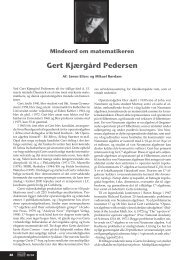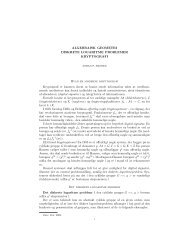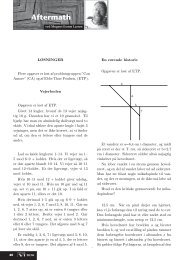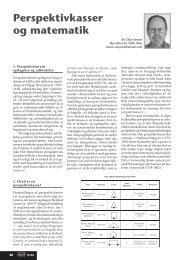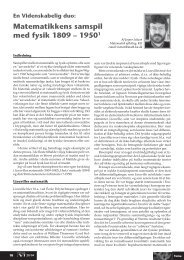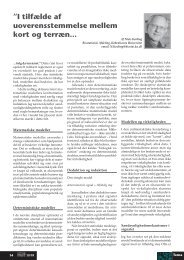MAT 15 - Matilde - Dansk Matematisk Forening
MAT 15 - Matilde - Dansk Matematisk Forening
MAT 15 - Matilde - Dansk Matematisk Forening
You also want an ePaper? Increase the reach of your titles
YUMPU automatically turns print PDFs into web optimized ePapers that Google loves.
Q7. How is mathematics research organized? Who is<br />
doing it, who is paying for it and why? Lonely,<br />
harmless riders, or highly efficient, highly organized,<br />
secret, threatening groups. Should one be scared?<br />
A7. The forward movement of mathematics is driven by<br />
two principal forces: forces on the inside of the subject<br />
and forces on the outside.<br />
Forces on the inside perceive certain questions or<br />
aspects that are incomplete, unanswered and call for answers.<br />
Or new mathematical ideas arising from free mental<br />
play come into prominence. “Lonely riders” very often<br />
make contributions.<br />
Forces on the outside call for the application of available<br />
mathematics to the outside world of people or things<br />
or they may result in the development of genuinely new<br />
mathematics.<br />
The work is paid for by institutions or organizations<br />
in anticipation of profit, or of scientific, social, national or<br />
cultural gain. The economically independent mathematical<br />
researcher exists, but is quite rare. NASA, the space<br />
agency, is a source of considerable mathematical support.<br />
In the years following 1939, and particularly in the<br />
U.S.A., a great deal of mathematical research has been<br />
paid for by the military, and individual mathematicians<br />
have profited by this support independently of their private<br />
views of U.S.A. military or foreign policy. Since war<br />
appears to be endemic to the human condition, military<br />
support will undoubtedly go on at some level.<br />
Support from the medical/health sector will gain in<br />
importance. The productivity of the United States gets a<br />
considerable boost from the “entertainment industry” and<br />
movies are using computer graphical software which has<br />
a considerable mathematical underlay.<br />
Some of work of the various groups is restricted or<br />
confidential. This may be for reasons of national security<br />
or for reasons of industrial confidentiality in a free and<br />
competitive market.<br />
In an ideal democratic society, all work must ultimately<br />
come into the open so that it may be judged both as<br />
regards its internal operation and its effects on society.<br />
Free and complete availability of information is one of<br />
the hallmarks of ideal science. While this has not always<br />
been the case in mathematical practice, judged over the<br />
past several centuries, the record is pretty good.<br />
Doing mathematics, developing new mathematics, is<br />
simply one type of human activity among thousands and<br />
thousands of activities. As long as constant scrutiny , judgement<br />
and dissent flourish, fear can be reduced.<br />
Q8. Other sciences have had their “breakthroughs” in<br />
the past 10-20 years. What breakthroughs does<br />
mathematics claim?<br />
A8. We might begin by discussing just what might be<br />
meant by the phrase “breakthrough in mathematics.” If<br />
we equate breakthroughs with prizes, and this equiva-<br />
18 20/04<br />
lence has a certain merit, then the work of e.g., the Fields<br />
Medal winners should be cited. This would cover Pure<br />
Mathematics where this prize, given since 1936, is the<br />
mathematical equivalent of the Nobel Prize. Similar prizes<br />
of substantional value exist in various pure mathematical<br />
specialties, in applied mathematics, statistics,<br />
computer science, etc.<br />
The work of Fields medal winners over the past decades,<br />
people such as K.F. Roth, R. Thom, M. Attiyah, P.J.<br />
Cohen, A Grothendieck, S. Smale, A. Baker, K. Hironaka,<br />
S.P. Novikoff, and J. Thompson, cannot, with some very<br />
few exceptions, be easily explained in lay terms. In view<br />
of their arcane nature, the public rarely hears about such<br />
things; and should a particular accomplishment reach the<br />
front page of the newspapers, its meaning is often mutilated<br />
by packaging it in the silver paper of sensation. Sensation<br />
is always easier for the public to grasp than substance.<br />
Judging from the selection of Fields Laureates, the criteria<br />
for the honor seem to be (1) the solution of old and<br />
difficult mathematical problems, (2) the unification of several<br />
mathematical fields through the discovery of cross<br />
connections and of new conceptualizations, (3) new internal<br />
developments.<br />
A few years ago the world of research mathematicians<br />
was electrified by the public announcement that the<br />
Clay Mathematics Institute, a private organization, was<br />
offering one million dollars each for the solution of seven<br />
famous mathematical problems<br />
We live in an Age of Sensation. As a result, only the<br />
“sensational” aspects of mathematics get much space in<br />
the newspapers: e.g., Fermat’s “Last Problem”, “the largest<br />
prime number now known is .... “ or the solution of<br />
other so-called “big” unsolved problems, big international<br />
students’ contests, etc.<br />
Mathematical applications that are useful, e.g., the<br />
programming and chipification of medical diagnostic<br />
equipment, are rarely considered as “breakthroughs” and<br />
make the front pages. Historic research or philosophic<br />
discussions of the influence of mathematics on society<br />
have yet to be honored in prestigious manners.<br />
Yet, from the point of view of affecting society, the<br />
major mathematical breakthrough since the end of World<br />
War II is the digital computer in all its ramifications.<br />
This breakthrough involved a very strong mix of mathematics<br />
and electronic technology and is not the brainchild<br />
of a single person; hundreds, if not hundred of thousands<br />
of people contributed and still contribute to it.<br />
Q9. Medical doctors fight cancer, AIDS and SARS.<br />
What is now the greatest challenge to modern<br />
mathematics?<br />
A9. One might distinguish between “internal” problems<br />
and “external” problems. The former are problems that<br />
are suggested by the operation of the mathematical di-



